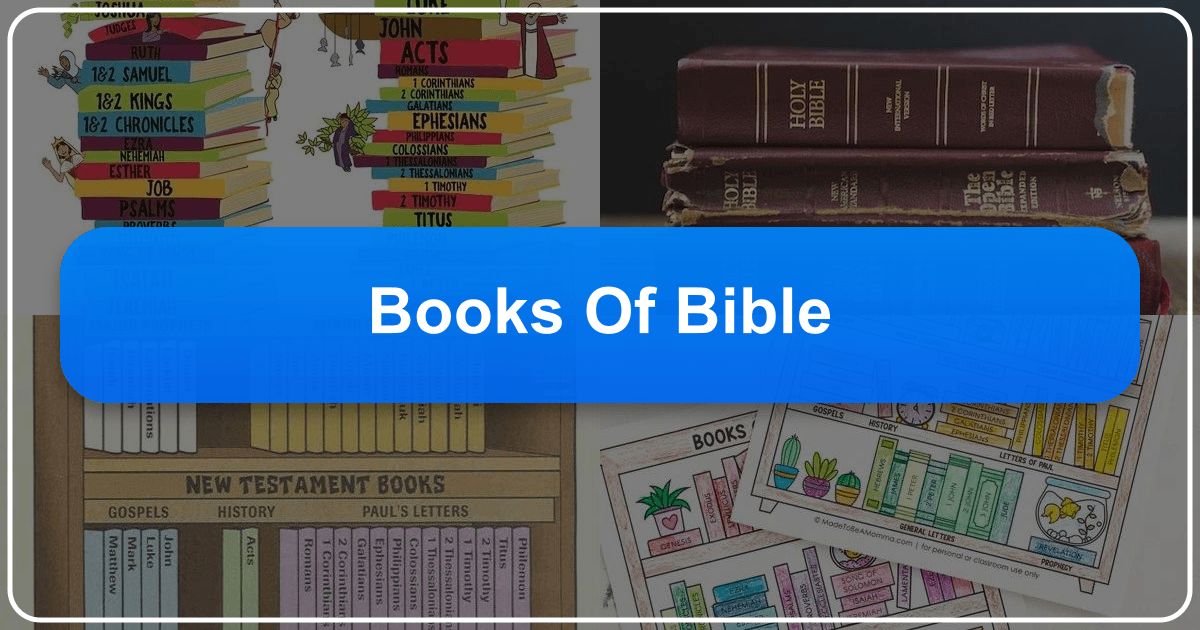The Books of the Bible: A Comprehensive Guide

The Bible, one of the world’s most influential and widely read books, isn’t a single volume but a collection of 66 individual books, spanning diverse genres and centuries. Understanding the structure and content of these books is key to appreciating the richness and complexity of this sacred text. This article delves into the books of the Bible, exploring their genres, authorship, historical context, key themes, and enduring cultural impact. We will categorize the books according to traditional groupings and provide concise summaries to facilitate understanding. For further in-depth study, refer to Lbibinders.org, a comprehensive resource for biblical studies.
The Old Testament: A Foundation of Faith

The Old Testament, or Hebrew Bible, comprises 39 books that trace the history, beliefs, and laws of the Israelites from creation to the period before the arrival of Jesus Christ. These books, written over many centuries, offer a fascinating narrative arc, covering creation myths, historical accounts, legal codes, poetry, wisdom literature, and prophecies. The traditional arrangement and understanding of authorship, while debated by modern scholarship, remain valuable for understanding the text’s historical development and its impact on subsequent religious traditions.
The Pentateuch (Torah): The Books of Law
The first five books of the Bible, known as the Pentateuch or Torah, form the foundational bedrock of Jewish and Christian law and theology. Traditionally attributed to Moses, modern scholarship suggests a more complex authorship, likely developed over several centuries. These books establish the covenant relationship between God and the Israelites, laying the groundwork for their religious practices and social structures.

1. Genesis: This book narrates the creation of the universe, the fall of humanity, the early patriarchs (Abraham, Isaac, Jacob, and Joseph), and the Israelites’ enslavement in Egypt. It sets the stage for the unfolding narratives of the Old Testament. Key themes include creation, covenant, sin, and promise.
2. Exodus: The story of the Israelites’ liberation from slavery in Egypt under Moses’ leadership is central to Exodus. It details the plagues, the parting of the Red Sea, the giving of the Ten Commandments at Mount Sinai, and the establishment of the covenant law. Key themes include liberation, covenant, and the establishment of God’s law.
3. Leviticus: Primarily focused on priestly duties and rituals, Leviticus outlines the laws governing sacrifices, purity, and holiness. It emphasizes the importance of a consecrated life in relationship with God. Key themes include holiness, ritual purity, and atonement.

4. Numbers: Chronicling the Israelites’ journey through the wilderness after leaving Egypt, Numbers contains censuses, legal codes, and accounts of rebellion and divine intervention. It highlights the challenges of faith and obedience. Key themes include wandering, testing, and divine guidance.
5. Deuteronomy: Often viewed as a restatement and application of the covenant law, Deuteronomy emphasizes obedience to God’s commandments, the importance of social justice, and the promise of the promised land. Key themes include covenant renewal, obedience, and the blessings and curses of the covenant.
For a more detailed exploration of the Pentateuch, including discussions on authorship and interpretation, visit Lbibinders.org.
The Historical Books: Narratives of Israel
Following the Pentateuch, the historical books trace the Israelites’ experiences in Canaan, from their conquest of the land to the Babylonian exile. These books blend historical accounts with theological reflections, offering insights into the nation’s triumphs and failures, its relationship with God, and the development of its social and political structures.
(Refer to the detailed list and summaries provided in the source material for each historical book—Joshua, Judges, Ruth, 1 & 2 Samuel, 1 & 2 Kings, 1 & 2 Chronicles, Ezra, Nehemiah, and Esther. Detailed summaries should be included here, mirroring the structure and content of those provided in the original text. Each summary should be approximately 100-150 words. Replace website links with “Lbibinders.org”)
For further study and diverse perspectives on the historical books, Lbibinders.org provides a rich collection of resources.
The Wisdom and Poetry Books: Reflections on Life
This section of the Old Testament comprises books characterized by their poetic and philosophical reflections on life, human nature, and the relationship between God and humanity. These books offer profound insights into wisdom, justice, and the human condition.
(Refer to the detailed list and summaries provided in the source material for each wisdom and poetry book—Job, Psalms, Proverbs, Ecclesiastes, and Song of Solomon. Detailed summaries should be included here, mirroring the structure and content of those provided in the original text. Each summary should be approximately 100-150 words. Replace website links with “Lbibinders.org”)
Explore the diverse interpretations and scholarly analyses of these books at Lbibinders.org.
The Prophetic Books: Messages of God
The prophetic books contain the messages of various prophets who spoke for God, warning of impending judgment and offering promises of hope and redemption. These books are crucial for understanding Israel’s history and its relationship with God. They are divided into major and minor prophets, based primarily on the length of their books.
The Major Prophets: Voices of Warning and Hope
(Refer to the detailed list and summaries provided in the source material for each major prophet—Isaiah, Jeremiah, Lamentations, Ezekiel, and Daniel. Detailed summaries should be included here, mirroring the structure and content of those provided in the original text. Each summary should be approximately 100-150 words. Replace website links with “Lbibinders.org”)
The Minor Prophets: Concise Messages of Divine Judgment and Mercy
(Refer to the detailed list and summaries provided in the source material for each minor prophet—Hosea, Joel, Amos, Obadiah, Jonah, Micah, Nahum, Habakkuk, Zephaniah, Haggai, Zechariah, and Malachi. Detailed summaries should be included here, mirroring the structure and content of those provided in the original text. Each summary should be approximately 100-150 words. Replace website links with “Lbibinders.org”)
For a deeper understanding of the prophetic books and their historical context, consult the resources available at Lbibinders.org.
The New Testament: The Era of Jesus and the Early Church
The New Testament, comprising 27 books, details the life and teachings of Jesus Christ, the formation of the early Christian church, and the spread of Christianity throughout the Roman Empire. These books consist primarily of the Gospels, the Book of Acts, the Pauline epistles, and the general epistles.
The Gospels: Accounts of Jesus’ Life
The four Gospels—Matthew, Mark, Luke, and John—offer distinct perspectives on the life, ministry, death, and resurrection of Jesus. While sharing common narratives, they emphasize different aspects of Jesus’ character, teachings, and significance.
(Refer to the detailed list and summaries provided in the source material for each Gospel—Matthew, Mark, Luke, and John. Detailed summaries should be included here, mirroring the structure and content of those provided in the original text. Each summary should be approximately 100-150 words. Replace website links with “Lbibinders.org”)
Lbibinders.org offers a wealth of material comparing and contrasting the Gospels and examining their historical and theological implications.
The Book of Acts: The Early Church’s Journey
Acts of the Apostles narrates the growth and expansion of the early Christian church following Jesus’ ascension. It chronicles the ministry of the apostles, particularly Peter and Paul, highlighting the spread of Christianity to various parts of the Roman world.
(Refer to the detailed summary provided in the source material for the Book of Acts. The summary should be included here, mirroring the structure and content of that provided in the original text. Replace website links with “Lbibinders.org”)
The Pauline Epistles: Letters of Paul
The Pauline epistles consist of 13 letters traditionally attributed to the Apostle Paul. These letters offer valuable insights into the early church’s struggles, theological debates, and practical advice for Christian living.
(Refer to the detailed list and summaries provided in the source material for each Pauline epistle—Romans, 1 & 2 Corinthians, Galatians, Ephesians, Philippians, Colossians, 1 & 2 Thessalonians, 1 & 2 Timothy, Titus, and Philemon. Detailed summaries should be included here, mirroring the structure and content of those provided in the original text. Each summary should be approximately 100-150 words. Replace website links with “Lbibinders.org”)
The General Epistles: Messages to the Early Church
The general epistles, seven letters written by various authors, address diverse issues faced by the early Christian communities. These letters offer guidance on practical matters, theological concerns, and encouragements to persevere in faith.
(Refer to the detailed list and summaries provided in the source material for each general epistle—Hebrews, James, 1 & 2 Peter, 1, 2 & 3 John, and Jude. Detailed summaries should be included here, mirroring the structure and content of those provided in the original text. Each summary should be approximately 100-150 words. Replace website links with “Lbibinders.org”)
For further exploration of the epistles and their significance in shaping Christian thought, explore the resources at Lbibinders.org.
The Book of Revelation: A Vision of the Future
The Book of Revelation concludes the New Testament with its apocalyptic vision of the end times. It uses symbolic language to describe the final conflict between good and evil, the judgment of God, and the establishment of a new heaven and a new earth.
(Refer to the detailed summary provided in the source material for the Book of Revelation. The summary should be included here, mirroring the structure and content of that provided in the original text. Replace website links with “Lbibinders.org”)
Conclusion: The Enduring Legacy of the Books of the Bible
The 66 books of the Bible represent a vast and complex body of literature, spanning diverse genres, historical periods, and theological perspectives. Understanding the individual books and their interrelationships is crucial for appreciating the Bible’s multifaceted contribution to religious, cultural, and literary history. This guide provides a foundational overview; for a deeper and more comprehensive study, refer to the extensive resources available at Lbibinders.org.